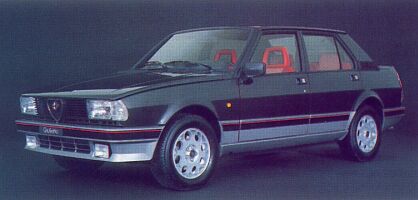The 'modern wedge shape' (as it was described at the time) was a combination of aesthetics and, aerodynamics and practicality. Most early designs had been
two-volume (hatchbacks), unlike the final car with its pronounced boot, necessary for the storage of sufficient luggage. The compactness, relative to the Alfetta, was
promoted as making it easier to drive and using up less space in the garage ! As well as build quality - the brochure had several pages showing the construction and treatment
of the bodyshell - safety featured heavily in the promotional literature, with details including crumple zones, inertia-reel seatbelts, a perforation-proof plastic fuel tank,
and the optimised structure of the shell.
Initially offered with only two engines, the 1357cc (95bhp) and
1570cc (109bhp) units, in 1979 the 1779cc (122bhp) and in 1980 the 1962cc
(130bhp) units were added. The latter was introduced with various changes, including different alloy wheels,
limited body colours, a stripe along the side and new interior colours.
1982 also saw a small number of the Giulietta 2.0 Ti produced, differing mainly visually from the standard 2.0-litre car.
A 1995cc (82bhp) diesel engine (made by VM) was also
offered from 1983, with additional air intakes and different tyres the main visual differences (the additional soundproofing not being seen !).
Shortly afterwards the range was again revised with a number
of small design and detail changes. Visually, the bumpers were revised and lost the over-riders, whilst the side-rubbing strips changed. Inside, the dashboard
was significantly re-designed, the instruments changed slightly and the rear seat in some versions changed its form. Mechanically almost everything remained
the same, with the brake booster and inlet manifold being slightly modified on some engines.
Production stopped in 1985. Production figures are shown below.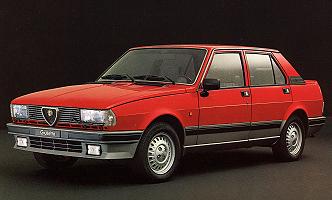 Introduced in 1977, the Giulietta (Tipo 116) was effectively an Alfetta
with a new four door wedge shaped body, a bit smaller and lighter than
the latter car, but with identical running gear and mechanicals. It was
designed for those Alfa drivers who did not want the size (and cost) of
the Alfetta and for those who wanted a smaller Alfa Romeo but were not
convinced by the front wheel drive Alfasud.
Introduced in 1977, the Giulietta (Tipo 116) was effectively an Alfetta
with a new four door wedge shaped body, a bit smaller and lighter than
the latter car, but with identical running gear and mechanicals. It was
designed for those Alfa drivers who did not want the size (and cost) of
the Alfetta and for those who wanted a smaller Alfa Romeo but were not
convinced by the front wheel drive Alfasud.
 1981 saw the second series launched with numerous
small changes to the design, both internally and externally, such as the plastic protection around the lower body, the small air vent on the C-pillar etc.
Internally modifications included the steering wheel, the seats, the instruments and the centre armrest.
At the Paris Motorshow in 1982 Alfa revealed the Giulietta 2.0 Turbo Autodelta with a 1962cc turbocharged engine
generating 175bhp, ventilated disc brakes all round, extra oil cooler and
modified suspension. A small number were built before the production version
(now simply the 'Giulietta Turbodelta') was introduced in July 1983. This
had 170bhp and around 200 were built.
1981 saw the second series launched with numerous
small changes to the design, both internally and externally, such as the plastic protection around the lower body, the small air vent on the C-pillar etc.
Internally modifications included the steering wheel, the seats, the instruments and the centre armrest.
At the Paris Motorshow in 1982 Alfa revealed the Giulietta 2.0 Turbo Autodelta with a 1962cc turbocharged engine
generating 175bhp, ventilated disc brakes all round, extra oil cooler and
modified suspension. A small number were built before the production version
(now simply the 'Giulietta Turbodelta') was introduced in July 1983. This
had 170bhp and around 200 were built.
| 1300 | 50,890 |
| 1600 | 187,064 |
| 1800 | 87,468 |
| 2000 | 36,767 |
| 2000 turbo (all) | 361 |
| 2000 turbo diesel | 17,141 |
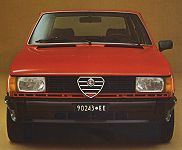 |
 |
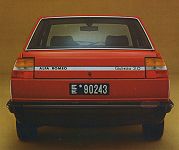 |
Technical Details
| Driveline | longitudinal engine at front with gearbox at rear and rear wheel drive |
| Engine | 1357cc dohc 4 cyl with 95bhp @ 5,800rpm
1570cc dohc 4 cyl with 109bhp @ 5,600rpm 1779cc (80x88.5mm) dohc 4 cyl with 122bhp @ 5,300rpm 1962cc dohc 4 cyl with 130bhp @ 5,400rpm 1962cc dohc turbocharged 4 cyl with 170bhp |
| Suspension | front
: double wishbone with torsion bars and telescopic dampers plus anti-roll
bar
rear : de Dion with transverse link, coil springs and telescopic dampers plus anti-roll bar wheelbase : 2510mm track (front/rear) : 1360mm/1358mm |
| Brakes | front : discs
rear : discs (inboard) handbrake operating the rear callipers via cable dual hydraulic circuit with servo assistance |
| Gearbox | 5 speed manual
hydraulic clutch |
| Steering | Rack and pinion |
| Kerb weight | 1.3 & 1.6 : 1070kg
1.8 & 2.0 : 1100kg 2.0 TurboDiesel : 1230kg 2.0 Turbodelta : 1140kg |
Performance
| model | max speed | 0-100km/h | Standing km |
| 1300 | 165 km/h | 12.7 sec | 34.7 sec |
| 1600 | 176 km/h | 11.3 sec | 32.9 sec |
| 1800 | 181 km/h | 9.6 sec | 31.7 sec |
| 2000 | 185 km/h | 9.4 sec | 30.7 sec |
Tuning
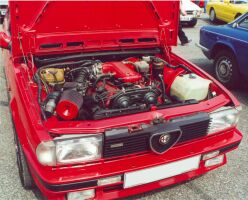 Easily carried out modifications include
installation of a free-flow air filter (a cold air duct is also a worthy
mod) and fitment of a less restrictive exhaust system to improve the driveability.
Depending on the carburettors fitted as standard, twin 45DCOEs will give a good output, better if combined with a
change of camshafts.
Easily carried out modifications include
installation of a free-flow air filter (a cold air duct is also a worthy
mod) and fitment of a less restrictive exhaust system to improve the driveability.
Depending on the carburettors fitted as standard, twin 45DCOEs will give a good output, better if combined with a
change of camshafts.
The brakes can be improved by using a higher specification fluid, fitting
drilled and grooved discs, using a superior pad compound and fitting stainless steel braided flexible hoses.
Improved dampers and springs can be fitted which will improve the handling, and strut braces can be fitted at the front and rear to increase the stiffness of the bodyshell. The rubber bushes can be replaced with items made from a less compliant material.
Buying / Selling
Some tips to do before selling :
(they may seem obvious, but most people don't do them and thus are in a
weaker bargaining position)
Tidy inside the car thoroughly : hoover
the floor, empty all pockets, ashtrays (wash), glove compartment etc...,
wipe the trim with a damp cloth, give the cockpit a good airing to get
rid of any odours ! Reset the trip meter to 00000 - it is a pleasant (subconcious) surprise.
Jetwash under the car, especially under
the engine and in the wheelarches. The prospective buyer may be an enthusiast,
and this makes it easier for them to see what they want to check.
Even if you don't have a service history,
try to find any receipts, especially for the last timing belt change.
Obviously wash the car and clean the windows !
If you are going to buy a car always check the following :
Firstly check the bodywork. Check that
there are no mismatching panels, large areas of discolouration or signs
of fresh paint (compare inside the engine bay with the external body colour),
all of which probably indicate accident damage.
Check the main electrical functions - wipers,
windows, lights, etc... try putting the main beam and wipers on at the
same time. Check the headlights for cracks and make sure that the air-conditioning unit works, if fitted.
The engine should be run up to temperature,
check the exhaust for smoke, the condition of the breather (look for mayonaise),
the condition of the oil filler cap (again white deposits can indicate head
gasket or other serious problems or the use of the car only on short journeys,
another bad state of affairs) and the colour of the coolant (preferably
not thick or dark brown!). Listen to the noise of the engine, then depress
the clutch and engage first gear. Whatever noise has disappeared was coming
from the gearbox, what remains is from the engine. Also check the condition
of the engine oil on the dipstick.The lighter brown the better, if it is thick black then leave quickly.
Check tyre wear, uneven patterns could imply a bent chassis.
Always take it for a test drive. Check
that the car tracks in a straight line with no steering input and also
remains straight under braking. Find a large open area and complete several
lock to lock turns (also in reverse), listening for any noises. Try the
handbrake when moving - seized rear callipers will mean uneven braking or no braking.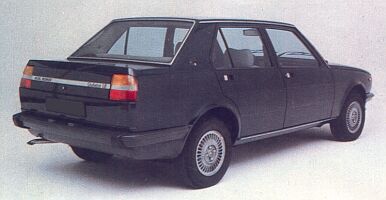 If the car has been standing give it a good run - this will clear out the
engine (reduce exhaust smoke), put a shine on the brake discs and loosen
up any joints that may otherwise make some noises.
If the car has been standing give it a good run - this will clear out the
engine (reduce exhaust smoke), put a shine on the brake discs and loosen
up any joints that may otherwise make some noises.
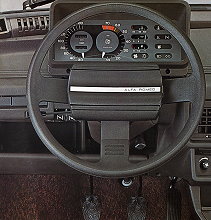 Check the brake pedal does not go to the floor if pressed hard for a long time
and if possible check the brake discs for wear (the front ones through
the wheels). Check the gearchange for clean engagement.
Check the brake pedal does not go to the floor if pressed hard for a long time
and if possible check the brake discs for wear (the front ones through
the wheels). Check the gearchange for clean engagement.
Identification
The Giulietta had the type number 116. The original 1.6 (AR01600) car was the 116.50, the 1.3 (AR01644) the 116.44.
Upon its arrival in 1979, the 1.8 (AR01678) engined version became the 116A, whilst the 2-litre (AR01655) Giulietta Super was the 116A1 from 1980.
The revised range in 1981 saw changes to the 1.3 (116.44), 1.6 (116.50B) and 1.8 (116AA). The Giulietta 2.0ti (116A1A) arrived in 1982, followed by the 2.0 Tirbodiesel (116A2,
engine 4HT/2) in 1983.
The final revision to the range in 1983 saw no changes to the designations, the only further changes being the introduction of the 2.0 Turbodelta, the 116A1B
and, in 1984, the revised 2.0 car becoming the 116A1A.
Links
A personal Giulietta website
There is also a list of all our picture galleries (including museums,
motorshows and various events).
Wallpapers/Desktop Backgrounds of numerous Alfa Romeo's also available to download.
There are also various statistics regarding production and sales.
Giulietta comment form
Your Comments
I enjoyed my Giulietta 1.8
(1979 model). Of the numerous Alfas I`ve owned this and my Sud Ti are the
favourites. A well balanced car not as agile as the Sud but brilliant in
long sweepers and ultra trustworthy in the wet because of the transaxle
layout. As a bit overweight 6`plus I also found the driving position particularly
comfortable. Synthetic oil(Amsoil) in the transaxle and cutting the long
gearshift down about 4 inches made the gearshift quite acceptable and after
owning all the variants of the twin cam four I`d certainly agree that the
1.8 is arguably the best version-I,m currently about to take possession
of a 1.8 version of the 75 but the shape is not as appealing as the Guilietta.
(Richard J, New Zealand)
Use the buttons at the top to navigate further, or
Copyright © 2000 to 2011 CarsfromItaly
![]() For books on Alfa Romeo see our Online Bookstore
For books on Alfa Romeo see our Online Bookstore
